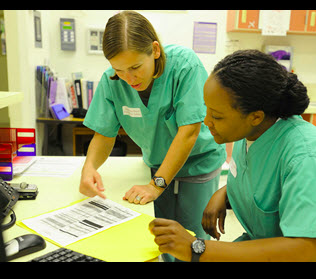Emergency room activity - enzyme inhibition
 This lesson introduces students to the medical use of enzyme inhibitors through a simple role play activity. Each student first completes a training course in toxicology covering the metabolism of alcohol and antifreeze (ethylene glycol) in the liver, the symptoms of antifreeze intoxication and some possible treatments. Then students are presented with two clinical cases of possible antifreeze poisoning. IT is up to the students to use their understanding of enzyme inhibition to decide on possible treatments for each patient.
This lesson introduces students to the medical use of enzyme inhibitors through a simple role play activity. Each student first completes a training course in toxicology covering the metabolism of alcohol and antifreeze (ethylene glycol) in the liver, the symptoms of antifreeze intoxication and some possible treatments. Then students are presented with two clinical cases of possible antifreeze poisoning. IT is up to the students to use their understanding of enzyme inhibition to decide on possible treatments for each patient.
Lesson Description
Guiding Question s
s
- How can we stop enzyme catalysed chemical reactions?
- How can doctors control enzymes to provide medical treatments?
- What is a competitive inhibitor?
Activity 1 - Introduction to in Alcohol & Ethylene glycol metabolism
Imagine that you are a junior doctor doing a toxicology course.
Read the following medical briefing sheets - Toxicology training course
Answer the questions at the end of each section and keep brief notes for yourself.
Alcohol dehydrogenase in the Protein data bank
Activity 2 - Role play - Doctor's surgery
A man and a young child were taken ill after a wedding reception at a local hotel and rush to hospital.
In groups of four share out the four role cards.
Read the details about the consultations which take place in a local emergency room. Try to recreate the consultation, .
- 2 patients (a 47 year old retired nutritionalist and his wife, a professor of chemistry, with their 3 year old baby)
- 2 junior doctors
Outline plan of the discussions
- Patients explain their symptoms & fill in the medical examination cards
- Doctors answer the patients' questions about what is wrong with them
- Patients keep notes for themselves
- Doctors send for tests & share the results with the patients
- Diagnoses is agreed and a treatment explained
Use ![]() the role play information sheets.
the role play information sheets.
(click the eye icon to display)
Activity 3 - Competitive or non-competitive inhibitors as drugs
To decrease the intracellular concentration of the products of alcohol dehydrogenase a non-competitive would be more effective than ethanol or fomepizole. The advantage of non-competitive inhibitors is that increasing the concentration of substrate does not affect a non-competitive inhibitor. The rate of the enzyme remains low.

Compete the questions on ![]() this worksheet shown below. to help you make structured notes about enzyme inhibition.
this worksheet shown below. to help you make structured notes about enzyme inhibition.
Teacher's notes
The first activity is a read and learn type 'training course' about the metabolism of alcohol and ethylene glycol in the human liver. (in fact in many organisms). Students are expected to read the materials and answer the simple multiple choice questions after each section. This should take 20 minutes but might take longer, especially if students want to make notes.
Activity 2 is a role play activity. Groups of four students rehearse and then perform or record an consultation in a hospital emergency department. This activity will take an hour to rehearse and perform / record but it could be done more quickly.
Group role play will mean every student will be involved in the discussions about metabolism and also about competitive inhibitors. Some teachers may prefer to have four students play the roles in a guided demonstration, the rest of the class could either take notes about different aspects, or may serve as prompters for the four characters.
Activity 3 is a summary worksheet with questions about competitive inhibition and non competitive inhibition. This will help to ensure that students have something written down from the lessons which can help them revise for exams. Sadly role plays are not yet part of the IB assessment system!
The role play was designed using some material from this toxicology training course from the US agency for toxic substances and disease registry. The content has been simplified and should not be taken as medical information.
Some resources for further information
Doctor training website on alcohol - www.stomponstep1.com/alcohol-metabolism-methanol-poisoning-fatty-change/
Reactome pathway tour - http://www.reactome.org/PathwayBrowser/#/R-HSA-71387&SEL
Drug database - fomepizole - http://www.drugs.com/pro/fomepizole.html
another drug database - http://www.drugbank.ca/drugs/DB01213
For more information about noncompetitive inhibitors in malaria treatments
Malaria resource database - https://www.ebi.ac.uk/chembl/malaria/

 IB Docs (2) Team
IB Docs (2) Team

